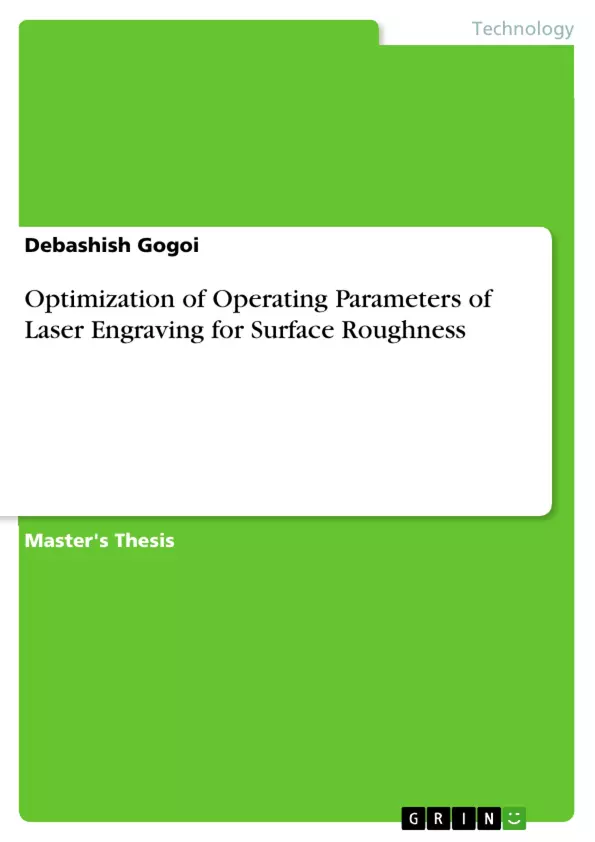In today's production and manufacturing industries, the laser cutting method is the broadly used nonconventional, advanced, non-contact type machining process. It has various advantages in using to cut or engrave almost all kinds of materials. In this study the effect of laser engraving parameters on filter paper were quantified using a mathematical model. The main objective of this study was to assess the individual and interaction effect of the input parameters on the surface quality of engraved portion under the experimental conditions that were based on the experimental design. From the experiment it was found that the laser power has the significant effect on the surface roughness. The interaction effect of the speed and number of dots per inch created by nozzle of the laser engraving machine and the quadratic effect of speed also have a significant effect on the output surface quality. It is seen that the roughness increases with the increase in the laser power. Also, it was found that the combination of low laser power and mid engraving speed can results in the good surface quality. Similarly, combination of low speed and DPI results in the good surface quality. Accordingly, interaction effect of low power and high DPI results the better surface quality. The best optimal setting was at 8W of laser power, 205.895 mm/sec of engraving speed and 299.9 numbers of dots per inch, the roughness was found as 5.5693 µm with the percentage error of 0.53%.
Inhaltsverzeichnis (Table of Contents)
- INTRODUCTION
- 1.1 Surface roughness
- 1.1.1 Surface roughness measurement
- 1.1.2 Roughness parameters
- 1.2 Laser cutting process
- 1.3 Problem statement
- 1.4 Thesis objective
- 1.1 Surface roughness
- LITERATURE REVIEW
- DESIGN OF EXPERIMENT
- 3.1 Experimental studies
- 3.2 Why design of experiment
- 3.3 Central composite design
- 3.4 Response surface methodology
- 3.4.1 RSM step-by-step application
- EXPERIMENTAL WORK
- 4.1 Selection of input factors and output response
- 4.2 Sample
- 4.3 Instruments used
- 4.4 Methodology
- 4.4.1 Problem formulation
- 4.4.2 Literature survey
- 4.4.3 Trial runs
- 4.4.4 Design matrix creation
- 4.4.5 Conduction of experiment
- 4.4.6 Data analysis and interpretation
- 4.4.7 Confirmation experiment
- 4.4.8 Conclusion
- Results and discussion
- 5.1 Development of mathematical model
- 5.1.1 Validation of model
- 5.2 Effect of process parameters on response
- 5.2.1 Contour plots
- 5.3 Optimization
- 5.4 Confirmation test
- 5.4.1 Percentage error
- 5.1 Development of mathematical model
- Conclusion and future scope
- 6.1 Conclusions
- 6.2 Future scopes
Zielsetzung und Themenschwerpunkte (Objectives and Key Themes)
This project report explores the optimization of laser engraving parameters for surface roughness. The main objective is to quantify the effect of laser engraving parameters on filter paper using a mathematical model. The report aims to analyze the individual and interaction effects of input parameters on the engraved surface quality under experimental conditions based on the experimental design. The research seeks to determine the optimal settings for laser engraving parameters to achieve the desired surface roughness. Key themes and ideas include:- Surface roughness and its measurement
- Laser cutting process and its application
- Design of experiment (DOE) methodology
- Response surface methodology (RSM) for parameter optimization
- Impact of laser power, speed, and dots per inch (DPI) on surface roughness
Zusammenfassung der Kapitel (Chapter Summaries)
- Chapter 1: Introduction: This chapter provides an overview of surface roughness, its measurement, and relevant roughness parameters. It also introduces the laser cutting process and the problem statement, highlighting the objective of optimizing laser engraving parameters for surface roughness.
- Chapter 2: Literature Review: This chapter reviews relevant literature on laser cutting, surface roughness, and the optimization of laser engraving parameters.
- Chapter 3: Design of Experiment: This chapter details the experimental design methodology used in the study, including the use of central composite design and response surface methodology. It explains the rationale behind employing DOE and RSM for this research.
- Chapter 4: Experimental Work: This chapter outlines the experimental setup, including the selection of input factors and output response, the sample used, and the instruments employed. It describes the experimental methodology, including the problem formulation, literature survey, trial runs, design matrix creation, experiment conduction, data analysis, confirmation experiment, and conclusions.
- Chapter 5: Results and discussion: This chapter presents the results of the experimental work, including the development of a mathematical model, its validation, and an analysis of the effects of process parameters on the response. It explores the use of contour plots for visualization and examines the optimization process.
Schlüsselwörter (Keywords)
The primary keywords and focus topics of this project report encompass laser engraving, surface roughness, filter paper, design of experiment (DOE), response surface methodology (RSM), laser power, engraving speed, dots per inch (DPI), and optimization. The report delves into the individual and interaction effects of these parameters on the surface quality of engraved filter paper, aiming to determine the optimal settings for achieving desired surface roughness.- Quote paper
- Debashish Gogoi (Author), 2020, Optimization of Operating Parameters of Laser Engraving for Surface Roughness, Munich, GRIN Verlag, https://www.grin.com/document/1144641



